Influence of the Urban Intersection Reconstruction on the Reduction of Road Traffic Noise Pollution
Abstract
:1. Introduction
2. Materials and Methods
2.1. Basic Principles of Traffic Noise Emissions
- p is the sound pressure [Pa],
- po is the reference sound pressure, po = 2 × 0−5 Pa.
- T is the integration interval, T = t2 − t1 [s].
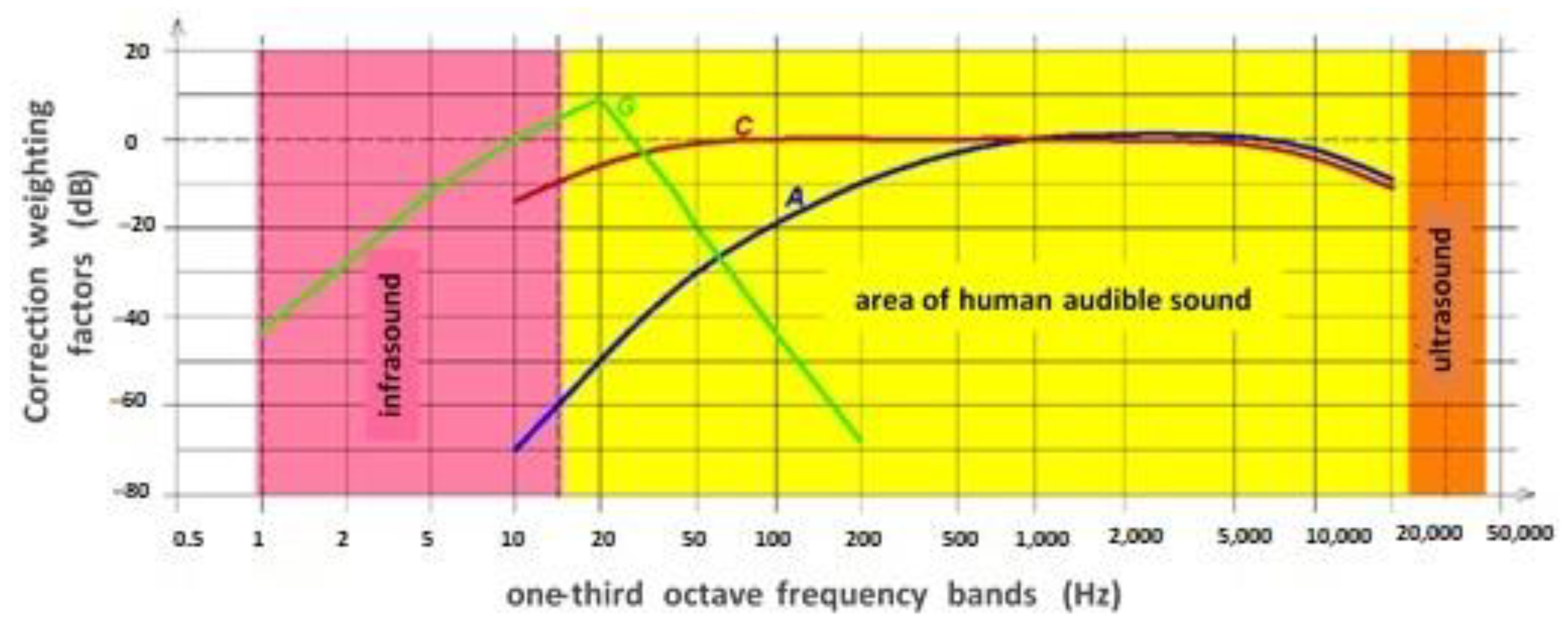
2.2. Admissible Road Traffic Noise Levels in the Slovak Republic
2.3. Study Area Used for the Reconstruction of Non-Signalized Intersections into Roundabouts from the Aspect of Noise Pollution
- Štefánikova–Saleziánov–Martina Rázusa streets (R1);
- Štefánikova–Okružná–Jána Švermu streets (R2);
- Jána Hollého–Moskovská–Okružná—Lastomírska streets (R3).
2.4. Objectification of the Impact of the Reconstruction of Intersections into Roundabouts on the Noise Load in the Vicinity of Residential Buildings
2.5. Modelling Noise
3. Results
3.1. Field Measurements
3.2. Road Traffic Noise Modelling
4. Discussion
5. Conclusions
Supplementary Materials
Author Contributions
Funding
Institutional Review Board Statement
Informed Consent Statement
Acknowledgments
Conflicts of Interest
References
- Hong, J.Y.; Jeon, J.Y. The effects of audio-visual factors on perceptions of environmental noise barrier performance. Landsc. Urban Plan. 2014, 125, 28–37. [Google Scholar] [CrossRef]
- Slabbekoorn, H.; Peet, M. Birds sing at a higher pitch in urban noise. Nature 2003, 424, 267. [Google Scholar] [CrossRef] [PubMed]
- Ouis, D. Annoyance from road traffic noise: A Review. J. Environ. Psychol. 2001, 21, 101–120. [Google Scholar] [CrossRef]
- Babisch, W.; Beule, B.; Schust, M.; Kersten, N.; Ising, H. Traffic noise and risk of myocardial infarction. Epidemiology 2005, 16, 33–40. [Google Scholar] [CrossRef] [PubMed]
- Van Kempen, E.; Babisch, W. The quantitative relationship between road traffic noise and hypertension: A meta-analysis. J. Hypertens. 2012, 30, 1075–1086. [Google Scholar] [CrossRef]
- Trollé, A.; Terroir, J.; Lavandier, C.; Marquis-Favre, C.; Lavandier, M. Impact of urban road traffic on sound unpleasantness: A comparison of traffic scenarios at crossroads. Appl. Acoust. 2015, 94, 46–52. [Google Scholar] [CrossRef]
- Hegewald, J.; Schubert, M.; Freiberg, A.; Starke, K.R.; Augustin, F.; Riedel-Heller, S.G.; Zeeb, H.; Seidler, A. Traffic Noise and Mental Health: A Systematic Review and Meta-Analysis. Int. J. Environ. Res. Public Health 2020, 17, 6175. [Google Scholar] [CrossRef]
- Sandberg, U.; Kalman, B.; Nilsson, R. Design Guidelines for Construction and Maintenance of Poroelastic Road Surfaces; Swedish National Road and Transport Research Institute (VTI): Linköping, Sweden, 2005. [Google Scholar]
- Durcanska, D.; Decky, M.; Licbinsky, R.; Huzlik, J. Project spens Sustainable pavement for European new member states. Commun.-Sci. Lett. Univ. Žilina 2013, 15, 49–55. [Google Scholar] [CrossRef]
- Licitra, G.; Cerchiai, M.; Teti, L.; Ascari, E.; Bianco, F.; Chetoni, M. Performance Assessment of Low-Noise Road Surfaces in the Leopoldo Project: Comparison and Validation of Different Measurement Methods. Coatings 2015, 5, 3–25. [Google Scholar] [CrossRef]
- Alves, S.; Scheuren, J.; Altreuther, B. Review of recent EU funded research projects from the perspective of urban sound planning: Do the results cope with the needs of Europe’s noise policy? Noise Mapp. 2016, 3, 86–106. [Google Scholar] [CrossRef]
- ISO. ISO 11819-1:1997; Acoustics—Measurement of the Influence of Road Surfaces on Traffic Noise—Part 1: Statistical Pass-By Method. Available online: https://www.iso.org/standard/20232.html (accessed on 23 July 2022).
- Mikhailenko, P.; Piao, Z.; Kakar, M.R.; Bueno, M.; Athari, S.; Pieren, R.; Heutschi, K.; Poulikakos, L. Low-Noise pavement technologies and evaluation techniques: A literature review. Int. J. Pavement Eng. 2022, 23, 1911–1934. [Google Scholar] [CrossRef]
- Andersen, B.; Kragh, J.; Bendsen, H. Acoustic performance-low noise road pavements. Acoust. Perform.-Low Noise Road Pavements 2006, 44. [Google Scholar]
- Gardziejczyk, W. The effect of time on acoustic durability of low noise pavements—The case studies in Poland. Transp. Res. Part D Transp. Environ. 2016, 44, 93–104. [Google Scholar] [CrossRef]
- Beyer, H.; Holtzblatt, K. Contextual design: Defining customer-centered systems. Morgan Kaufmann Publ. 1998, 32, 500. [Google Scholar]
- Beyer, H.; Holtzblatt, K. Contextual design. Interactions 1999, 6, 32–42. [Google Scholar] [CrossRef]
- RockwellChris Customer connection creates a winning product. Interactions 1999, 6, 50–57. [CrossRef]
- McDonald, S.; Monahan, K.; Cockton, G. Modified contextual design as a field evaluation method. ACM Int. Conf. Proceeding Ser. 2006, 189, 437–440. [Google Scholar] [CrossRef]
- McCullough, M. On the Urbanism of Locative Media. Places 2006, 18, 26–29. [Google Scholar]
- Liauw, F. Reference for contextual design. IOP Conf. Ser. Mater. Sci. Eng. 2019, 508, 012031. [Google Scholar] [CrossRef]
- Waldheim, C. Landscape as urbanism: A general theory. Landsc. J. 2016, 35, 304–306. [Google Scholar] [CrossRef]
- Babu, G.S.; Saride, S.; Basha, B.M. Sustainability Issues in Civil Engineering; Sivakumar Babu, G.L., Saride, S., Basha, B.M., Eds.; Springer Transactions in Civil and Environmental Engineering; Springer: Singapore, 2017; ISBN 978-981-10-1928-9. [Google Scholar]
- Beukes, E.; Vanderschuren, M.; Zuidgeest, M.; Brussel, M.; van Maarseveen, M. Quantifying the Contextual Influences on Road Design. Comput. Civ. Infrastruct. Eng. 2013, 28, 344–358. [Google Scholar] [CrossRef]
- Margorínová, M.; Trojanová, M.; Decký, M.; Remišová, E. Noise costs from road transport. Civ. Environ. Eng. 2018, 14, 12–20. [Google Scholar] [CrossRef]
- Trojanová, M.; Margorínová, M.; Kowalska-Koczwara, A. Quantification and Valuation of Travel Time Costs Due to Road Works in the Integrated System of Road Economic Evaluation. Civ. Environ. Eng. 2019, 15, 166–173. [Google Scholar] [CrossRef] [Green Version]
- Sramek, J.; Hodasova, K.; Juhas, M.; Pitonak, M.; Duris, L. Rutting Prediction Models in Holistic Concept to Sustainability of Semi-Rigid Pavements. Civ. Environ. Eng. 2022, 18, 200–208. [Google Scholar] [CrossRef]
- Gardziejczyk, W.; Motylewicz, M. Noise level in the vicinity of signalized roundabouts. Transp. Res. Part D Transp. Environ. 2016, 46, 128–144. [Google Scholar] [CrossRef]
- Bakowski, A.; Dekýš, V.; Radziszewski, L.; Skrobacki, Z. Validation of traffic noise models. AIP Conf. Proc. 2019, 2077, 020005. [Google Scholar] [CrossRef]
- Bąkowski, A.; Radziszewski, L. Analysis of traffic noise in two cross-sections at the road crossing the city. Commun.-Sci. Lett. Univ. Žilina 2021, 23, B13–B21. [Google Scholar] [CrossRef]
- Motylewicz, M.; Gardziejczyk, W. Statistical model for traffic noise prediction in signalised roundabouts. Bull. Polish Acad. Sci. Tech. Sci. 2020, 68, 937–948. [Google Scholar] [CrossRef]
- Hradil, J.; Uhlik, M.; Slabý, P. Application of multi-criteria assessment for the selection of at-grade intersections. Mater. Infrastruct. 1 2016, 5, 335–348. [Google Scholar]
- Titu, A.M.; Boroiu, A.A.; Mihailescu, S.; Pop, A.B.; Boroiu, A. Assessment of Road Noise Pollution in Urban Residential Areas—A Case Study in Piteşti, Romania. Appl. Sci. 2022, 12, 4053. [Google Scholar] [CrossRef]
- Džambas, T.; Ahac, S.; LastNameDragčević, V. The impact of intersection type on traffic noise levels in residential areas. In Proceedings of the 3rd International Conference on Road and Rail Infrastructures—CETRA 2014, Spilt Dalmatia, Croatia, 28–30 April 2014. [Google Scholar]
- Covaciu, D.; Florea, D.; Timar, J. Estimation of the noise level produced by road traffic in roundabouts. Appl. Acoust. 2015, 98, 43–51. [Google Scholar] [CrossRef]
- Desarnaulds, V.; Monay, G.; Carvalho, A. Noise reduction by urban traffic management. In Proceedings of the ICA 2004, Granada, Spain, 22–24 September 2004. [Google Scholar]
- Distefano, N.; Leonardi, S. Experimental investigation of the effect of roundabouts on noise emission level from motor vehicles. Noise Control Eng. J. 2019, 67, 282–294. [Google Scholar] [CrossRef]
- Ahac, S.; Ahac, M.; Domitrović, J.; Dragčević, V. Modeling the influence of roundabout deflection on its efficiency as a noise abatement measure. Sustainability 2021, 13, 5407. [Google Scholar] [CrossRef]
- Lumnitzer, E.; Biľová, M.; Polačeková, J. Psychoacoustic analysis of traffic noise. In Proceedings of the 12th International Multidisciplinary Scientific Geoconference SGEM 2012; Stef92 Technology, Albena, Bulgaria, 17–23 June 2012; pp. 649–654. [Google Scholar]
- Bartels, S.; Rooney, D.; Müller, U. Assessing aircraft noise-induced annoyance around a major German airport and its predictors via telephone survey—The COSMA study. Transp. Res. Part D Transp. Environ. 2018, 59, 246–258. [Google Scholar] [CrossRef]
- Sutheeraakul, C.; Kronprasert, N. Functional and contextual classification concept for road network in Thailand: Preliminary study. In Proceedings of the 2019 First International Conference on Smart Technology & Urban Development (STUD), Chiang Mai, Thailand, 13–14 December 2019; pp. 55–60. [Google Scholar] [CrossRef]
- Spišáková, M.; Mésároš, P.; Mandičák, T. Construction Waste Audit in the Framework of Sustainable Waste Management in Construction Projects—Case Study. Buildings 2021, 11, 61. [Google Scholar] [CrossRef]
- Spišáková, M.; Mandičák, T.; Mésároš, P.; Špak, M. Waste Management in a Sustainable Circular Economy as a Part of Design of Construction. Appl. Sci. 2022, 12, 4553. [Google Scholar] [CrossRef]
- United Nations. Transforming Our World: The 2030 Agenda for Sustainable Development; United Nations: New York, NY, USA, 2015. [Google Scholar]
- Ministère de l’Équipement. NMPB-Routes 96—Bruit des Infrastructures Routières, Méthode de Calcul Incluant les France Effets Météorologiques; Ministère de l’Équipement: Tunis, Tunisia, 1997. [Google Scholar]
- Dutilleux, G.; Defrance, J.; Ecotière, D.; Gauvreau, B.; Bérengier, M.; Besnard, F.; Duc, E. Le NMPB-routes-2008: The revision of the french method for road traffic noise prediction. Acta Acust. United Acust. 2010, 96, 452–462. [Google Scholar] [CrossRef]
- Ministry of Health of the Slovak Republic. Decree of the Ministry of Health of the Slovak Republic no. 549/2007 Coll., Laying Down Details on Admissible Values of Noise, Infrasound and Vibration and Requirements for the Objectification of Noise, Infrasound and Vibration in the Environment; Ministry of Health of the Slovak Republic: Bratislava, Slovakia, 2007. [Google Scholar]
- Durcanska, D.; Decky, M.; Drliciak, M.; Jandacka, D.; Papan, D. Road Transport and the Environment; Universty of Zilina: Zilina, Slovakia, 2019; ISBN 978-80-554-1632-8. [Google Scholar]
- Decky, M.; Leitner, B.; Kortis, J.; Bugala, M.; Sobota, J. Objectification of Mechanical Vibration Induced by Road Traffic, 1st ed.; University of Zilina: Zilina, Slovakia, 2019. (In Slovak) [Google Scholar]
- Krokker, A. Environmental Capacity of Roads from the Aspect of Their Noise Immissions; University of Zilina: Zilina, Slovakia, 2012. [Google Scholar]
- STN ISO 1996-1:2019; Acoustics. Description, Measurement and Assessment of Environmental Noise. Part 1: Basic Quantities and Assessment Procedures. Slovak Office of Standards, Metrology and Testing: Bratislava, Slovakia, 2019.
- STN ISO 1996-1:2019; Acoustics. Description, Measurement and Assessment of Environmental Noise. Part 2: Determination of Sound Pressure Levels. Slovak Office of Standards, Metrology and Testing: Bratislava, Slovakia, 2019.
- Vorläufige Berechnungsmethode für den Umgebungslärm an Straßen (VBUS, German Interim Calculation Method for Road Noise). Bundesanzeiger, 17 August 2006; Volume 58. (In German)
- 003/613/EC; Commission Recommendation of 6 August 2003 Concerning the Guidelines on the Revised Interim Computation Methods for Industrial Noise, Aircraft Noise, Road Traffic Noise and Railway Noise, and Related Emission Data (Notified under Document Number C(2003) 2807). European Commission: Brussels, Belgium, 2003.
- Mikolaj, J. Socio-economical impact of noise mitigation through rubber modified porous asphalt surfacing. In Proceedings of the International Multidisciplinary Scientific GeoConference Surveying Geology and Mining Ecology Management, SGEM, Albena, Bulgaria, 17–26 June 2014; Volume 3, pp. 385–392. [Google Scholar]
- Decky, M.; Kováč, M.; Remišová, E. Environmentally Progressive Road Traffic Noise Reducing Devices and Materials. Appl. Mech. Mater. 2016, 832, 144–151. [Google Scholar] [CrossRef]
- Remisova, E.; Decky, M.; Kovac, M. The influence of the asphalt mixture composition on the pavement surface texture and noise emissions production. In Proceedings of the 14th International Multidisciplinary Scientific Conference SGEM, Albena, Bulgaria, 7–26 June 2014. [Google Scholar]
- Decky, M. Noise pollution from roundabout traffic in the outer environment of built-up areas of towns. Perner’s Contacts 2009, 4, 53–68. [Google Scholar]
- Jandacka, D.; Decky, M.; Durcanska, D. Traffic Related Pollutants and Noise Emissions in the Vicinity of Different Types of Urban Crossroads. In Proceedings of the IOP Conference Series: Materials Science and Engineering, Wuhan, China, 10–12 October 2019; Volume 661. [Google Scholar]
- Liberko, M.; Ladys, L. Calculation of Noise from Road Traffic; Enviconsult Prague and Ekola group, s.r.o.: Prague, Czech Republic, 2011. (In Czech) [Google Scholar]
- Public Health Authority of the Slovak Republic. Professional Guidance of the Public Health Authority of the Slovak Republic, which Regulates the Procedure for Developing Strategic Noise Maps. Annex no. 1: The French Calculation Method “NMPB Routes 96” According to the French Standard “XPS 31-133” with the Application Modification for the Conditions of the Slovak Republic; Public Health Authority of the Slovak Republic: Bratislava, Slovakia, 2005. [Google Scholar]
- Kephalopoulos, S.; Paviotti, M.; Anfosso-Lédée, F. Common Noise Assessment Methods in Europe (CNOSSOS-EU); Publications Office of the European Union: Luxembourg, 2012. [Google Scholar]
- STN EN 14388:2016; Road Traffic Noise Reducing Devices—Specifications. Slovak Office of Standards, Metrology and Testing: Bratislava, Slovakia, 2019.
- Briliak, D.; Remišová, E. Research into effect of asphalt mixture aging on stiffness. Transp. Res. Procedia 2021, 55, 1251–1257. [Google Scholar] [CrossRef]
- Khajehvand, M.; Rassafi, A.A.; Mirbaha, B. Modeling traffic noise level near at-grade junctions: Roundabouts, T and cross intersections. Transp. Res. Part D Transp. Environ. 2021, 93, 102752. [Google Scholar] [CrossRef]
- Chevallier, E.; Can, A.; Nadji, M.; Leclercq, L. Improving noise assessment at intersections by modeling traffic dynamics. Transp. Res. Part D Transp. Environ. 2009, 14, 100–110. [Google Scholar] [CrossRef]
- Fernandes, P.; Tomás, R.; Acuto, F.; Pascale, A.; Bahmankhah, B.; Guarnaccia, C.; Granà, A.; Coelho, M.C. Impacts of roundabouts in suburban areas on congestion-specific vehicle speed profiles, pollutant and noise emissions: An empirical analysis. Sustain. Cities Soc. 2020, 62, 102386. [Google Scholar] [CrossRef]
- Lu, X.; Kang, J.; Zhu, P.; Cai, J.; Guo, F.; Zhang, Y. Influence of urban road characteristics on traffic noise. Transp. Res. Part D Transp. Environ. 2019, 75, 136–155. [Google Scholar] [CrossRef]
- Ambros, J.; Novák, J.; Borsos, A.; Hóz, E.; Kieć, M.; MacHciník, Š.; Ondrejka, R. Central European Comparative Study of Traffic Safety on Roundabouts. Transp. Res. Procedia 2016, 14, 4200–4208. [Google Scholar] [CrossRef]
- Šurdonja, S.; Dragčević, V.; Deluka-Tibljaš, A. Analyses of maximum-speed path definition at single-lane roundabouts. J. Traffic Transp. Eng. Engl. Ed. 2018, 5, 83–95. [Google Scholar] [CrossRef]
- Elżbieta, M. Roundabouts as aesthetic road solutions for organizing landscapes. Sci. J. Silesian Univ. Technol. Ser. Transp. 2022, 115, 53–62. [Google Scholar] [CrossRef]
- Estévez-Mauriz, L.; Forssén, J. Dynamic traffic noise assessment tool: A comparative study between a roundabout and a signalised intersection. Appl. Acoust. 2018, 130, 71–86. [Google Scholar] [CrossRef]
- Quartieri, J.; Mastorakis, N.E.; Guarnaccia, C.; Troisi, A.; D’Ambrosio, S.; Iannone, G. Traffic noise impact in road intersections. Int. J. Energy Environ. 2010, 1, 1–8. [Google Scholar]
- Maghrour Zefreh, M.; Torok, A.; Zitricky, V. Theoretical Comparison of the Effects of Different Traffic Conditions on Urban Road Traffic Noise. J. Adv. Transp. 2018, 2018, 7949574. [Google Scholar] [CrossRef] [Green Version]

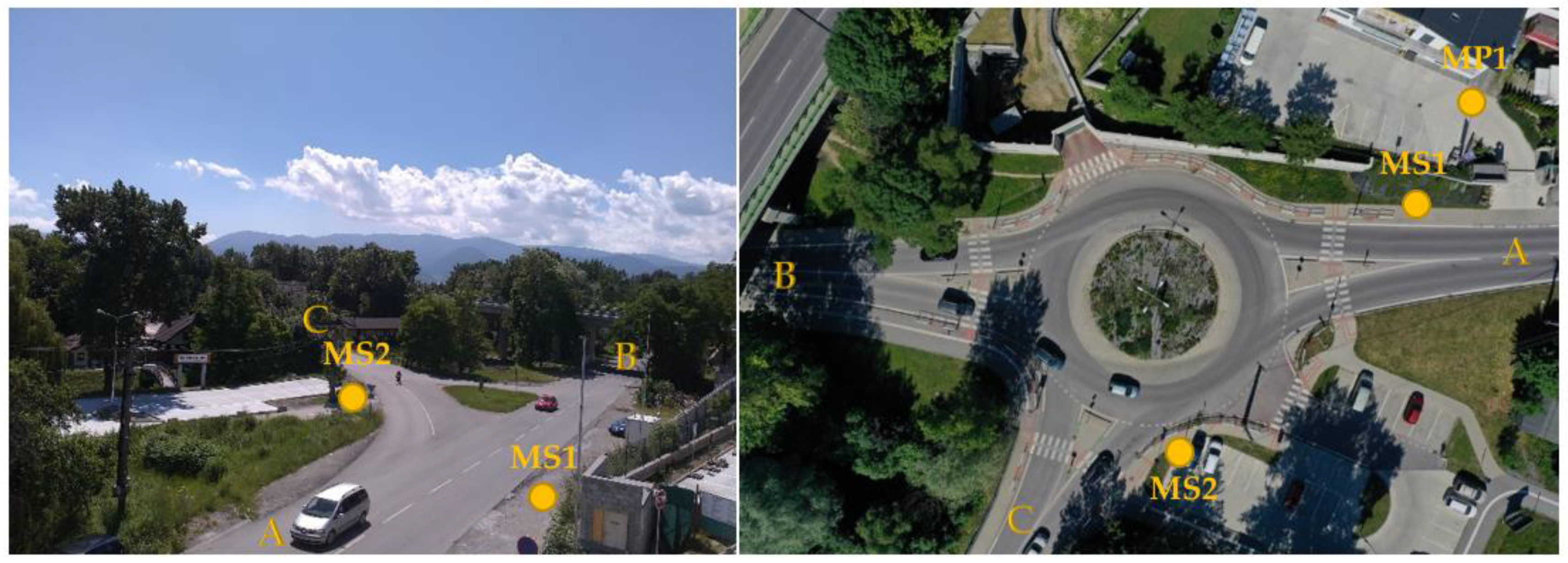
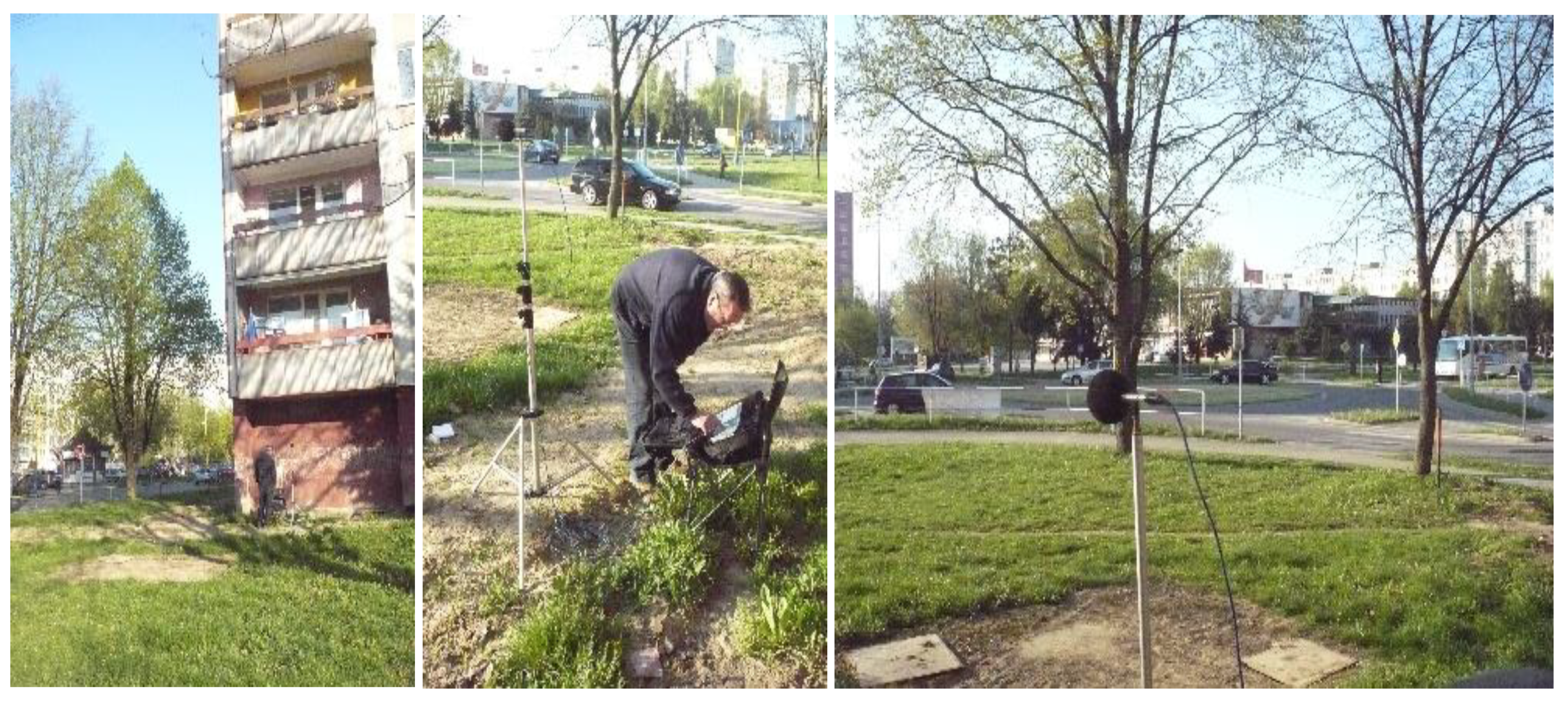
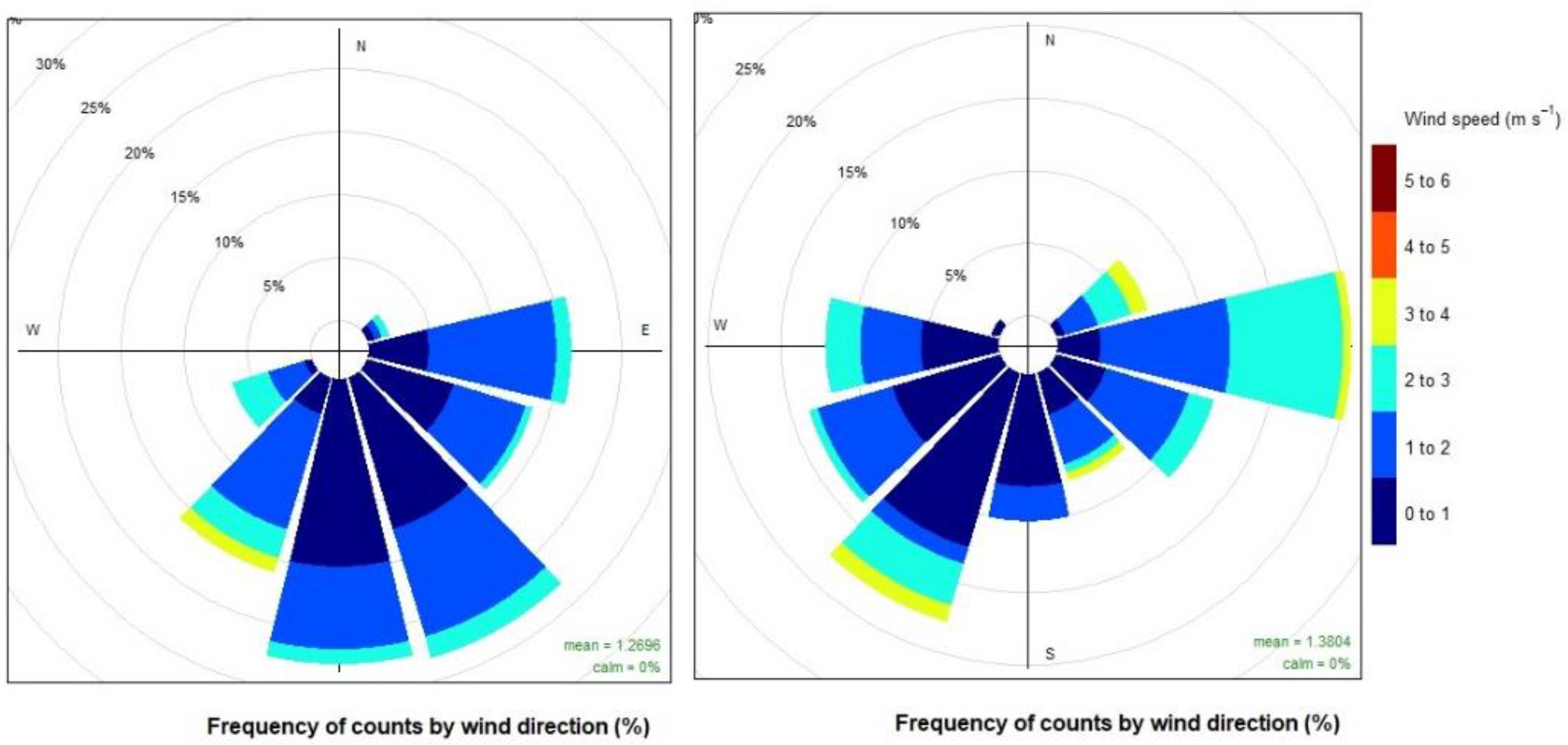
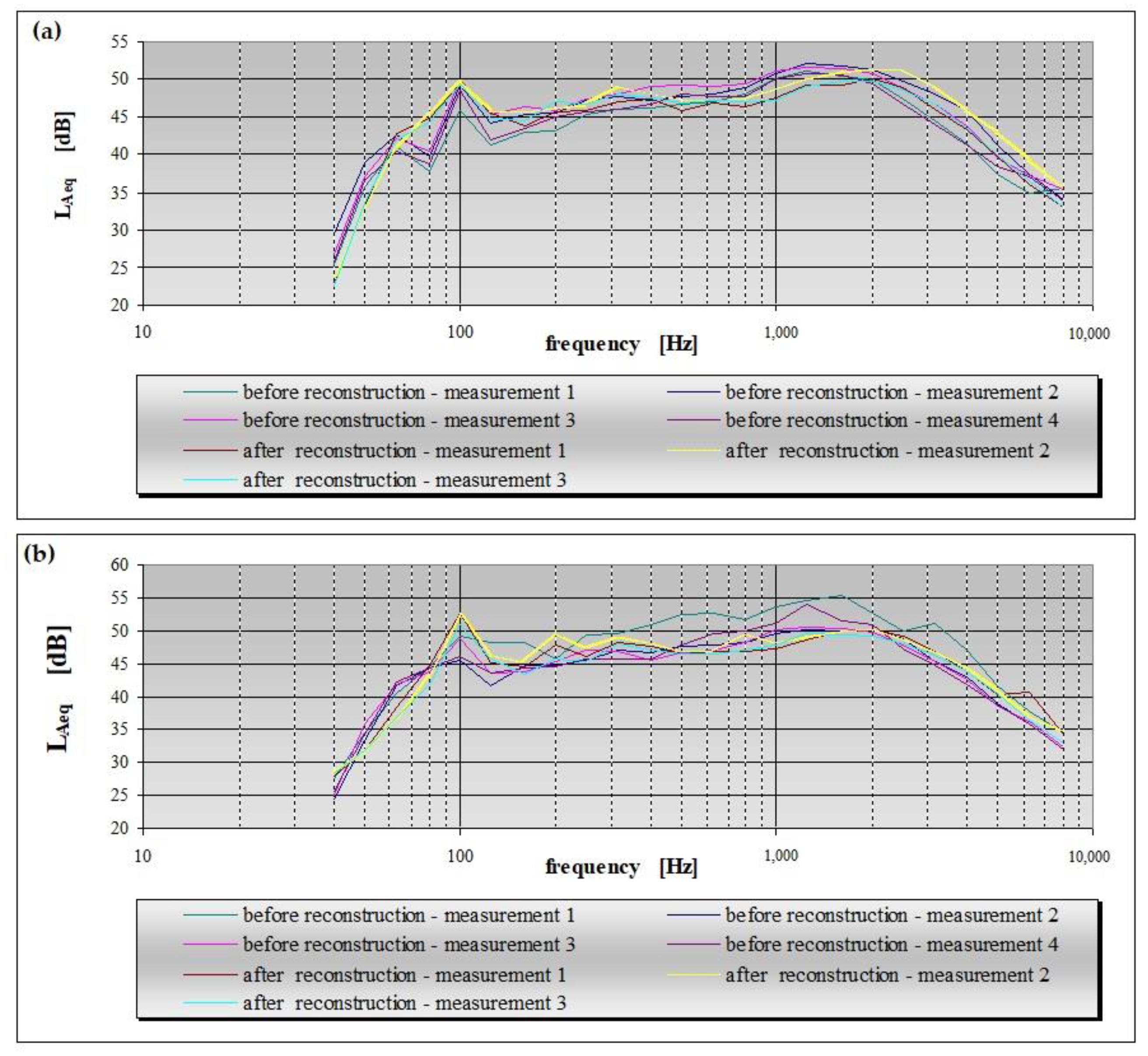
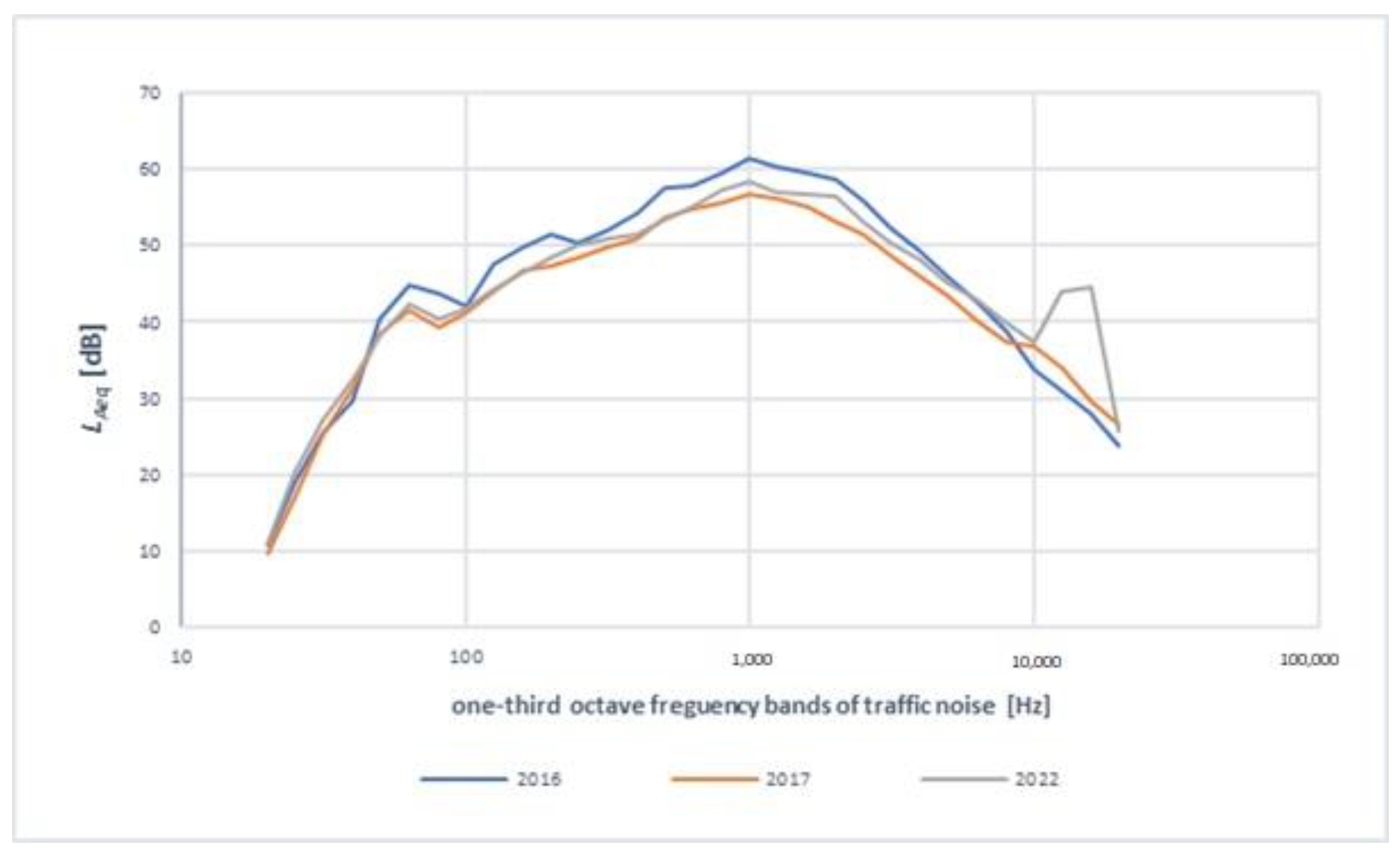
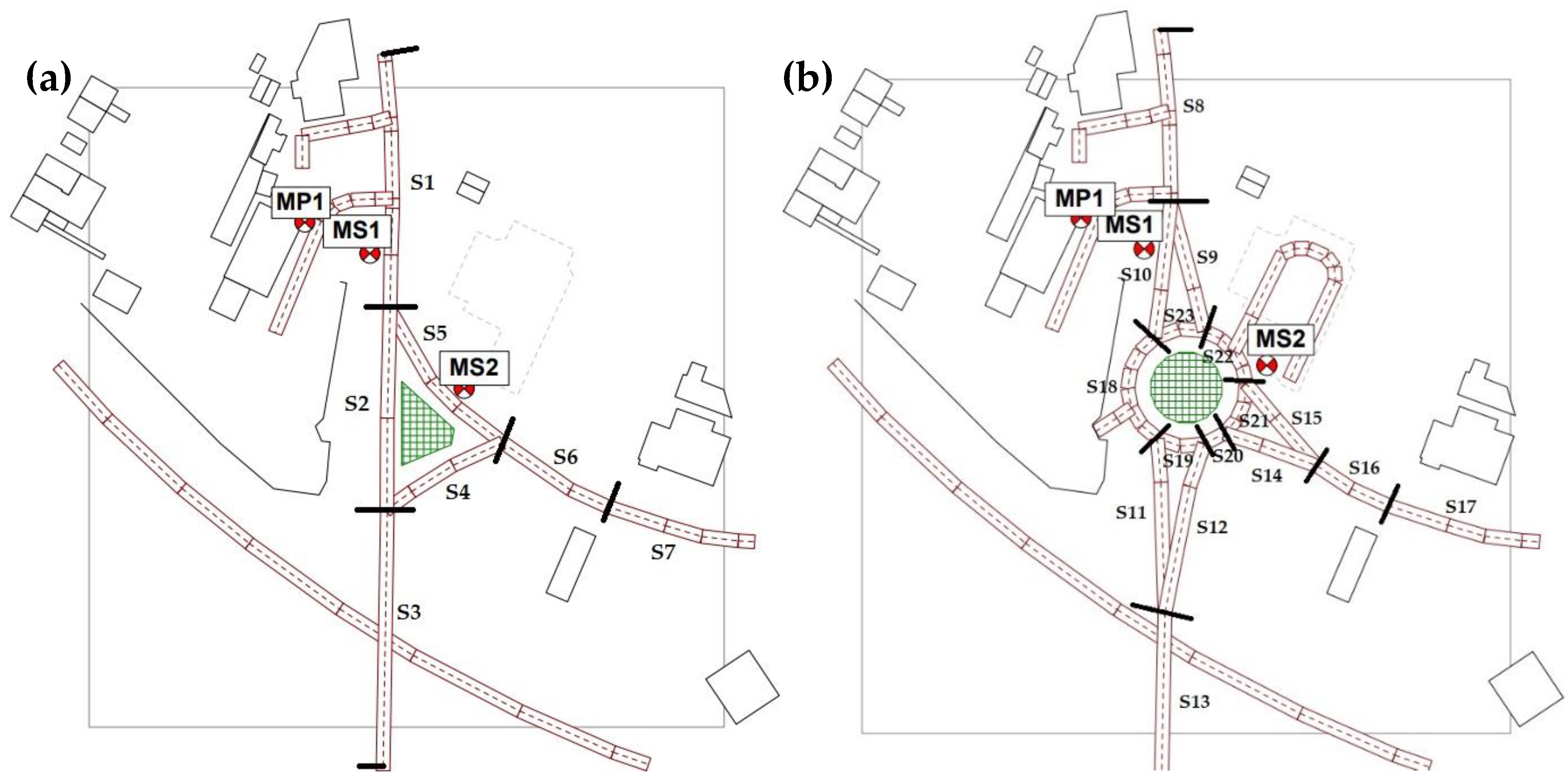



| Territory Category | Description of the Outdoor Environment | Time Interval | Admissible Values (dB) | |||
|---|---|---|---|---|---|---|
| Traffic Noise | ||||||
| Road and Water Transport LAeq,a | Railways LAeq,a | Air Transport | ||||
| LAeq,a | LASmax,a | |||||
| II. | Areas in front of windows of residential rooms; protected rooms, such as school buildings, medical facilities, and other protected buildings; and outdoor territories in residential and recreational areas | day | 50 | 50 | 55 | - |
| evening | 50 | 50 | 55 | - | ||
| night | 45 | 45 | 45 | 65 | ||
| III. | Areas in category II near motorways and roads of classes I and II, local public transport roads, railways, airports, and city centers | day | 60 | 60 | 60 | - |
| evening | 60 | 60 | 60 | - | ||
| night | 50 | 55 | 50 | 75 | ||
| Intersection | Before | After | ||
|---|---|---|---|---|
| Traffic Volume (veh/h) | p (%) | Traffic Volume (veh/h) | p (%) | |
| R1 | 1091 | 2.5 | 1006 | 2.6 |
| R2 | 1235 | 2.8 | 1156 | 2.6 |
| R3 | 885 | 3.8 | 903 | 3.6 |
| Road Type | Day (6–18 h) | Evening (18–22 h) | Night (22–6 h) | |||
|---|---|---|---|---|---|---|
| Q (veh/h) * | p (%) | Q (veh/h) * | p (%) | Q (veh/h) * | p (%) | |
| Local Road | 0.062 * MDTD | 5 | 0.042 * MDTD | 3 | 0.011 * MDTD | 6 |
| Traffic Volume at the Intersection Entrance (veh/24 h) | |||
|---|---|---|---|
| Intersection/Entrance | A | B | C |
| T_16 | 5702 | 6763 | 3222 |
| R_17 | 5333 | 7311 | 3876 |
| Three-Arm Intersection (T_16) | |||
| Entrance to the Intersection | A | B | C |
| A | 0% | 69% | 31% |
| B | 57% | 0% | 43% |
| C | 37% | 63% | 0% |
| Roundabout (R_17, R_22) | |||
| Entrance to the Intersection | A | B | C |
| A | 0% | 69% | 31% |
| B | 63% | 0% | 37% |
| C | 43% | 57% | 0% |
| Intersection Arms (Profiles) | The Average Speed of Vehicles [km/h] | |||
|---|---|---|---|---|
| Three-Arm Intersection (T_16) | Roundabout (R_17, R_22) | |||
| Passenger Cars | Freight Vehicles | Passenger Cars | Freight Vehicles | |
| B | 52 | 48 | 50 | 43 |
| A | 44 | 37 | 40 | 32 |
| C | 43 | 33 | 35 | 25 |
| Equivalent Noise Level from Road Traffic [dB] at the Intersection before and after Reconstruction to R1 | |||||
| Before | LAeq,15 min | After | LAeq,15 min | ||
| 29 May 2006 1100 to 1200 | 59.5 | 61.1 | 12 March 2007 1030 to 1115 | 58.6 | 58.7 |
| 61.1 | 59.8 | 58.3 | - | ||
| 29.5.2006 LAeq,1 h = 60.4 dB and 12.3.2007 LAeq,45 min = 58.5 dB | |||||
| Equivalent Noise Level from Road Traffic [dB] at the Intersection before and after Reconstruction to R2 | |||||
| 29 May 2006 1230 to 1330 | 63.7 | 60.0 | 12 March 2007 1200 to 1300 | 58.9 | 58.5 |
| 60.0 | 61.0 | 59.5 | - | ||
| 29.5.2006 LAeq,1 h = 61.5 dB and 12.3.2007 LAeq,45 min = 59.0 dB | |||||
| Equivalent Noise Level from Road Traffic [dB] at the Intersection before and after Reconstruction to R3 | |||||
| 12 March 2007 1200 to 1300 | 56.6 | 57.4 57.9 | 29 April 2008 1030 to 1115 | 55.3 | 55.0 |
| 58.3 | 54.5 | 54.4 | |||
| 12.3.2007 LAeq,1 h = 57.6 dB and 29.4.2008 LAeq,45 min = 54.8 dB | |||||
| Intersection (Scenario) | Modelling Point/Measuring Station | LAeq,day [dB] | LAeq,evening [dB] | LAeq,night [dB] | LAeq,day,m [dB] |
|---|---|---|---|---|---|
| T_16 | MP1 | 62.9 | 60.6 | 56.9 | - |
| MS1 | 70.7 | 67.9 | 63.8 | 68.9 | |
| MS2 | 69.0 | 66.1 | 62.3 | 68.0 | |
| R_17 | MP1 | 60.0 | 57.5 | 54.2 | - |
| MS1 | 67.4 | 64.3 | 60.7 | 65.5 | |
| MS2 | 67.5 | 64.4 | 60.8 | 65.1 | |
| R_22 | MP1 | 61.0 | 58.5 | 55.2 | - |
| MS1 | 68.4 | 65.3 | 61.7 | 66.3 | |
| MS2 | 68.5 | 65.4 | 61.8 | 65.9 |
Publisher’s Note: MDPI stays neutral with regard to jurisdictional claims in published maps and institutional affiliations. |
© 2022 by the authors. Licensee MDPI, Basel, Switzerland. This article is an open access article distributed under the terms and conditions of the Creative Commons Attribution (CC BY) license (https://creativecommons.org/licenses/by/4.0/).
Share and Cite
Jandacka, D.; Decky, M.; Hodasova, K.; Pisca, P.; Briliak, D. Influence of the Urban Intersection Reconstruction on the Reduction of Road Traffic Noise Pollution. Appl. Sci. 2022, 12, 8878. https://doi.org/10.3390/app12178878
Jandacka D, Decky M, Hodasova K, Pisca P, Briliak D. Influence of the Urban Intersection Reconstruction on the Reduction of Road Traffic Noise Pollution. Applied Sciences. 2022; 12(17):8878. https://doi.org/10.3390/app12178878
Chicago/Turabian StyleJandacka, Dusan, Martin Decky, Katarina Hodasova, Peter Pisca, and Dusan Briliak. 2022. "Influence of the Urban Intersection Reconstruction on the Reduction of Road Traffic Noise Pollution" Applied Sciences 12, no. 17: 8878. https://doi.org/10.3390/app12178878






